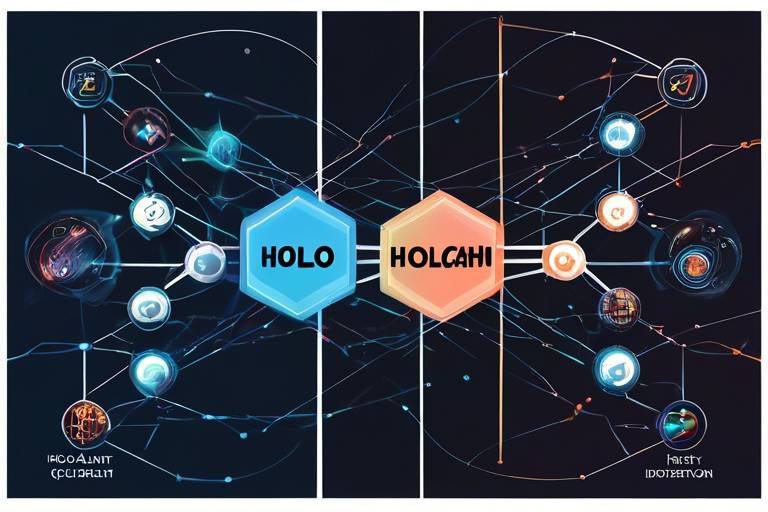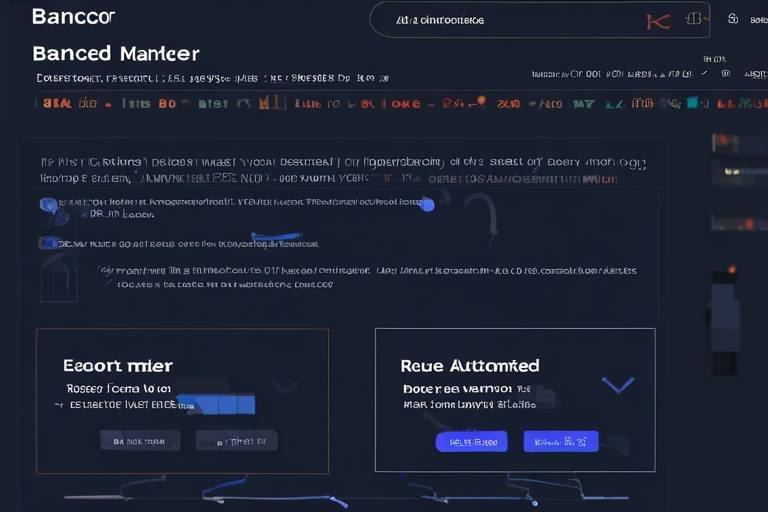Kyber Network - Liquidity for Decentralized Finance
In the fast-paced world of cryptocurrency, liquidity is a critical component that can make or break a trading experience. Enter Kyber Network, a trailblazer in the decentralized finance (DeFi) landscape that is revolutionizing how users interact with digital assets. Imagine a bustling marketplace where traders can exchange goods effortlessly, without the need for a middleman. That’s precisely what Kyber Network offers, providing a platform that aggregates liquidity from various sources, allowing users to swap tokens directly from their wallets. This innovation not only enhances user experience but also fosters a thriving ecosystem where traders can capitalize on the opportunities that the DeFi space presents.
At its core, Kyber Network is a decentralized liquidity protocol designed to facilitate seamless token swaps. It connects various liquidity sources, ensuring that users can access the best prices available in real-time. Think of Kyber as a bridge linking traders and liquidity providers, creating a fluid market where transactions occur without the usual delays associated with traditional exchanges. By empowering users to trade directly from their wallets, Kyber simplifies the process, making it more intuitive and user-friendly. This approach not only democratizes access to DeFi but also places users in control of their assets, enhancing their overall trading experience.
So, how does Kyber Network manage to deliver such a seamless trading experience? The secret lies in its innovative use of smart contracts. These self-executing contracts automate the trading process, allowing users to exchange tokens instantly. When a trader initiates a swap, the smart contracts kick in, connecting the trader with liquidity providers to ensure that they receive the best possible rates while minimizing slippage. This mechanism is akin to having a personal assistant who knows the best deals in town and ensures you get them without any hassle.
One of the standout features of Kyber Network is its ability to aggregate liquidity from multiple sources. This aggregation means that users can tap into a diverse range of liquidity pools, ensuring they can access the most competitive rates for their trades. With Kyber, you’re not limited to a single source of liquidity; instead, you can enjoy the benefits of a vast network that enhances trading efficiency. This feature is especially crucial in a market where price fluctuations can happen in the blink of an eye, making it essential for traders to act quickly and capitalize on favorable conditions.
Liquidity providers are the lifeblood of Kyber Network. By supplying tokens to the network, they play a crucial role in maintaining its liquidity. In return for their contributions, liquidity providers earn fees, creating a win-win situation for all parties involved. Their participation not only enhances the overall liquidity but also boosts trading efficiency, making it easier for users to execute their trades without delays. In essence, liquidity providers are akin to the farmers in a marketplace, ensuring that there’s always enough produce available for buyers.
Another significant advantage of Kyber Network is its contribution to price stability in the DeFi market. By offering a wide array of liquidity options, it helps to reduce the volatility often associated with token trading. This stability is crucial for traders who seek to minimize risks while maximizing their potential returns. With Kyber, users can trade with confidence, knowing that they have access to a reliable liquidity source that helps maintain fair market prices.
The backbone of Kyber Network is its smart contracts, which ensure that every transaction is executed with transparency, security, and efficiency. These contracts are designed to automate the trading process, eliminating the need for intermediaries and reducing the chances of human error. By leveraging blockchain technology, Kyber provides a level of trust and security that is essential for user confidence in the decentralized finance space. It’s like having a trustworthy referee in a game, ensuring that all rules are followed and that everyone plays fair.
Kyber Network offers a plethora of advantages that make it a go-to choice for traders and investors in the DeFi landscape. Some of these benefits include:
- Low Transaction Fees: Kyber minimizes costs associated with trading, making it accessible for everyone.
- Instant Trades: The platform allows for real-time transactions, enabling users to act quickly on market opportunities.
- User-Friendly Interface: With a focus on simplicity, Kyber ensures that even novice users can navigate the platform with ease.
One of the primary goals of Kyber Network is to enhance user experience. By allowing trades directly from wallets without the need for intermediaries, it eliminates unnecessary steps that can complicate the trading process. This accessibility is essential for attracting new users to the DeFi ecosystem, as it removes barriers that may have previously deterred them from participating in the market.
Kyber Network doesn’t operate in isolation; it seamlessly integrates with various decentralized applications (dApps) and wallets. This interoperability enhances the overall DeFi experience for users, allowing them to access a broader range of services and functionalities. Imagine having a universal remote that controls all your devices; that’s the kind of convenience Kyber brings to the table, making it easier for users to manage their assets across different platforms.
As the DeFi landscape continues to evolve, Kyber Network is well-positioned to adapt and innovate. Its commitment to providing liquidity and enhancing user experience will play a significant role in shaping future developments in the space. With ongoing advancements in technology and an ever-growing user base, Kyber is set to remain a key player in the DeFi arena, continually pushing the boundaries of what’s possible in decentralized finance.
- What is Kyber Network? Kyber Network is a decentralized liquidity protocol that aggregates liquidity from various sources to facilitate seamless token swaps.
- How does Kyber Network ensure the best prices? By aggregating liquidity from multiple sources, Kyber ensures users can access the most competitive rates for their trades.
- Who are liquidity providers? Liquidity providers are users who supply tokens to the network, earning fees in return for their contributions.
- What advantages does Kyber Network offer? Kyber offers low transaction fees, instant trades, and a user-friendly interface, making it a favored choice in the DeFi space.

Understanding Kyber Network
This article explores the Kyber Network, its role in providing liquidity for decentralized finance (DeFi), and its impact on the evolving cryptocurrency landscape.
Kyber Network is not just another player in the crowded field of decentralized finance; it is a revolutionary liquidity protocol that aggregates liquidity from a multitude of sources. Imagine a bustling marketplace where buyers and sellers can meet without the need for a middleman—this is the essence of what Kyber Network offers. It allows users to trade tokens directly from their wallets, creating an experience that is not only seamless but also empowering. Users no longer have to rely on centralized exchanges that can impose hefty fees and long wait times; instead, they can execute trades instantly, making the entire process feel like a walk in the park.
One of the standout features of Kyber Network is its ability to provide access to a diverse range of tokens. This is crucial in a market where new tokens are constantly being introduced. By aggregating liquidity from various sources, Kyber ensures that users can find the best rates available, thereby enhancing their trading experience. Think of it as having a personal assistant who scours the market for the best deals, allowing you to make informed decisions without the hassle.
But how does this all work? At the heart of Kyber Network are smart contracts that facilitate these instant token exchanges. These contracts are like the invisible hands that guide the trading process, ensuring that everything runs smoothly and securely. When a user wants to swap one token for another, the smart contract kicks in, automatically connecting them with liquidity providers who have the tokens they need. This not only ensures that users receive the best prices for their transactions but also minimizes slippage, which is the difference between the expected price of a trade and the actual price.
To give you a clearer picture, let’s break down the components of Kyber Network:
| Component | Description |
|---|---|
| Liquidity Aggregation | Combines liquidity from multiple sources for better trading rates. |
| Smart Contracts | Automate trades, ensuring transparency and security. |
| User Wallets | Allows users to trade directly without intermediaries. |
In summary, Kyber Network is a game-changer in the DeFi space, providing users with an efficient, transparent, and user-friendly platform to trade tokens. Its innovative approach to liquidity aggregation and smart contract functionality not only enhances the user experience but also contributes to the overall stability of the DeFi market. As we delve deeper into how Kyber Network operates, it becomes clear that it is not just about trading; it’s about creating an ecosystem where users can thrive without the constraints of traditional finance.
- What is Kyber Network? Kyber Network is a decentralized liquidity protocol that aggregates liquidity from various sources to facilitate seamless token swaps.
- How does Kyber Network work? It operates through smart contracts that connect liquidity providers and traders, ensuring users receive the best prices for their transactions.
- What are the benefits of using Kyber Network? Users enjoy low transaction fees, instant trades, and a user-friendly interface, making it a popular choice in the DeFi landscape.

How Kyber Network Works
Understanding how Kyber Network operates is crucial for anyone looking to dive into the world of decentralized finance (DeFi). At its core, Kyber Network functions through a series of smart contracts that automate the process of token exchanges. Imagine these smart contracts as digital vending machines: you insert a token, and out comes another token, all without the need for a middleman. This direct interaction between users and the network not only simplifies the trading process but also enhances the overall user experience.
When you want to swap tokens, Kyber Network connects you with various liquidity providers who have supplied their tokens to the network. This connection is made possible by the aggregation of liquidity from multiple sources, which ensures that you receive the best possible rates for your transactions. The magic happens in real-time, allowing for instant trades that are executed at optimal prices while minimizing slippage—the difference between the expected price of a trade and the actual price.
To illustrate how this works, let’s consider a simple example. Suppose you want to exchange Ethereum (ETH) for DAI, a stablecoin. When you initiate this trade, Kyber Network’s smart contracts will check the available liquidity across its network and present you with the best rates from different liquidity providers. This not only ensures you get a fair deal but also enhances the overall trading efficiency.
Additionally, the role of liquidity providers is vital. They contribute tokens to the Kyber ecosystem, allowing traders to access a diverse range of tokens. In return, these providers earn fees based on the trades executed using their liquidity. This symbiotic relationship creates a robust ecosystem where both traders and liquidity providers benefit.
Another key aspect of Kyber Network is its ability to maintain price stability. By offering a wide array of liquidity options, it reduces the volatility often seen in token trading. This stability is essential for traders who want to minimize risks associated with sudden price fluctuations. The more liquidity available, the less likely it is for large trades to impact the market significantly.
In summary, Kyber Network operates as a decentralized liquidity protocol that leverages smart contracts to facilitate seamless token swaps. By connecting traders with liquidity providers, it ensures that users receive the best prices while maintaining a stable trading environment. This innovative approach not only enhances user experience but also contributes to the overall health of the DeFi ecosystem.
- What is Kyber Network? Kyber Network is a decentralized liquidity protocol that aggregates liquidity from various sources to enable seamless token swaps.
- How does Kyber Network ensure low fees? By connecting multiple liquidity providers, Kyber Network can offer competitive rates, minimizing transaction costs for users.
- Can I trade directly from my wallet? Yes, Kyber Network allows users to trade directly from their wallets without the need for intermediaries.
- What is slippage? Slippage refers to the difference between the expected price of a trade and the actual price at which the trade is executed.

Liquidity Aggregation
At the heart of the Kyber Network lies the innovative concept of . This process is akin to gathering streams from various rivers to create a powerful waterfall. By pooling liquidity from multiple sources, Kyber ensures that users can access the best available rates for their token swaps. Imagine trying to find the best price for a concert ticket; you wouldn’t just check one website, right? You’d explore multiple platforms to snag the best deal. That’s exactly what Kyber does for cryptocurrency trading.
When a user wants to swap tokens, Kyber Network taps into its extensive liquidity pool, which is sourced from various decentralized exchanges (DEXs) and liquidity providers. This aggregation mechanism not only enhances the efficiency of trades but also ensures that users experience minimal slippage. Slippage can be a trader’s worst nightmare, especially in the volatile world of cryptocurrencies, where prices can change within seconds. By providing a multitude of options, Kyber significantly reduces this risk.
Furthermore, the diversity of tokens available on the Kyber platform is impressive. Users can trade a wide range of cryptocurrencies without the hassle of navigating multiple exchanges. This is particularly beneficial for traders who seek to diversify their portfolios without incurring hefty fees or spending excessive time on complex processes. The ability to swap tokens directly from their wallets, combined with the liquidity aggregation feature, creates a seamless trading experience that is both user-friendly and efficient.
To illustrate the impact of liquidity aggregation, consider the following table which highlights some of the key advantages:
| Advantage | Description |
|---|---|
| Best Prices | By aggregating liquidity from various sources, Kyber offers users the best possible rates for their trades. |
| Reduced Slippage | With access to a larger pool of liquidity, users experience less price impact during trades. |
| Diverse Token Availability | Users can easily trade a wide array of tokens without navigating multiple platforms. |
| Efficient Trading | Quick and seamless trades improve the overall user experience in the DeFi space. |
In summary, liquidity aggregation is not just a feature of the Kyber Network; it is a fundamental aspect that empowers users to engage in decentralized finance with confidence. By ensuring that traders have access to the best rates and minimizing slippage, Kyber Network stands out as a pivotal player in the ever-evolving DeFi landscape.
- What is liquidity aggregation?
Liquidity aggregation is the process of pooling liquidity from various sources to provide users with the best possible rates for token swaps.
- How does Kyber Network ensure low slippage?
By connecting to multiple liquidity sources, Kyber minimizes the impact of price changes during trades, ensuring users get better prices.
- Can I trade any token on Kyber Network?
Kyber supports a wide range of tokens, allowing users to trade various cryptocurrencies directly from their wallets.
- Is Kyber Network user-friendly?
Yes, Kyber prioritizes user experience, enabling seamless trades without the need for intermediaries.

Role of Liquidity Providers
Liquidity providers are the unsung heroes of the Kyber Network, playing a pivotal role in maintaining the ecosystem's fluidity and efficiency. Think of them as the lifeblood of the network; without their contributions, the entire system could falter. By supplying tokens to the network, liquidity providers enable users to execute trades swiftly and at competitive prices. In return for their contribution, these providers earn fees, which act as an incentive to keep them engaged and active within the platform.
But what exactly does it mean to be a liquidity provider? Essentially, these individuals or entities deposit their assets into the Kyber Network, making them available for trading. This process not only enhances liquidity but also ensures that there are enough tokens available for users looking to swap or trade. The more liquidity there is in the system, the better the trading experience for everyone involved. It's a win-win situation!
Moreover, liquidity providers are crucial in reducing slippage, which is the difference between the expected price of a trade and the actual price. When there’s ample liquidity, users can trade larger amounts without significantly affecting the market price. This stability is particularly important in the volatile world of cryptocurrencies.
To illustrate the importance of liquidity providers, consider the following table that highlights their contributions:
| Contribution | Impact |
|---|---|
| Token Supply | Increases available assets for trading |
| Fee Earnings | Provides financial incentive for participation |
| Market Stability | Reduces price volatility and slippage |
| Enhanced Trading Experience | Allows for smoother and faster transactions |
In summary, liquidity providers are not just participants; they are essential to the very fabric of the Kyber Network. By supplying tokens and facilitating trades, they contribute to a more dynamic and efficient decentralized finance ecosystem. As the DeFi landscape continues to grow and evolve, the role of liquidity providers will become even more significant, driving innovation and enhancing user experience.
- What is a liquidity provider? A liquidity provider is an individual or entity that supplies tokens to a trading platform, enabling smoother and faster transactions for users.
- How do liquidity providers earn fees? They earn fees based on the volume of trades that occur using the tokens they have supplied to the network.
- Why is liquidity important in DeFi? Adequate liquidity reduces slippage and price volatility, ensuring a better trading experience for users.
- Can anyone become a liquidity provider? Yes, anyone with tokens can become a liquidity provider by depositing their assets into the Kyber Network.

Impact on Price Stability
The Kyber Network plays a pivotal role in enhancing price stability within the decentralized finance (DeFi) ecosystem. By aggregating liquidity from a multitude of sources, it creates a robust environment where users can trade tokens with greater confidence. Imagine a bustling marketplace where buyers and sellers converge, each transaction contributing to a more stable pricing structure. This is essentially what Kyber Network achieves in the crypto space.
One of the primary ways Kyber promotes price stability is through its ability to minimize slippage. Slippage occurs when the price of a token changes between the time a trade is initiated and when it is executed. With Kyber's liquidity aggregation model, users can access a wider range of liquidity pools, which means they are less likely to experience significant price shifts during their transactions. This is crucial for traders who aim to execute their trades at the best possible price without unexpected changes.
Furthermore, the diverse liquidity options available on Kyber Network mean that traders can execute larger transactions without drastically affecting the market price. When liquidity is plentiful, the impact of a single trade on the overall market diminishes. This is particularly important in a landscape where token prices can be notoriously volatile. By providing a steady stream of liquidity, Kyber helps to cushion the market against abrupt price fluctuations, thereby fostering a more stable trading environment.
To illustrate this, consider the following table that highlights the relationship between liquidity and price stability:
| Liquidity Level | Price Volatility | Market Impact |
|---|---|---|
| High | Low | Minimal |
| Medium | Moderate | Noticeable |
| Low | High | Significant |
This table clearly shows that as liquidity levels rise, price volatility tends to decrease, leading to a more stable market. Hence, Kyber Network's commitment to providing ample liquidity is not just a feature; it is a fundamental aspect of its contribution to price stability in the DeFi sector.
In summary, the impact of Kyber Network on price stability cannot be overstated. By ensuring that liquidity is always available, it not only enhances the trading experience for users but also contributes to a healthier and more resilient market overall. This stability is essential for attracting new participants to the DeFi space, as traders and investors alike seek environments where their assets can grow with reduced risk of sudden price swings.
- What is Kyber Network? Kyber Network is a decentralized liquidity protocol that aggregates liquidity from various sources, allowing users to trade tokens directly from their wallets.
- How does Kyber Network ensure price stability? By providing access to a wide array of liquidity options, Kyber minimizes slippage and reduces the impact of large trades on market prices.
- Can I trade any token on Kyber Network? Kyber supports a diverse range of tokens, making it possible for users to trade many different cryptocurrencies seamlessly.
- How do liquidity providers benefit from Kyber Network? Liquidity providers earn fees for supplying tokens to the network, enhancing the overall liquidity and trading efficiency.

Smart Contract Functionality
The backbone of Kyber Network lies in its robust smart contracts, which serve as the engine driving the entire liquidity protocol. Imagine these contracts as the invisible hands that facilitate every transaction, ensuring that everything runs smoothly and efficiently. They are programmed to execute trades automatically, eliminating the need for intermediaries and allowing users to engage in token exchanges directly from their wallets.
One of the most appealing aspects of Kyber's smart contracts is their transparency. Each transaction is recorded on the blockchain, meaning that users can verify the legitimacy of their trades without relying on a third party. This transparency fosters a sense of trust, which is crucial in the often volatile world of decentralized finance (DeFi). Furthermore, the automation provided by these smart contracts significantly reduces the chances of human error, making the trading process not only faster but also more reliable.
Additionally, the smart contracts are designed to ensure security. They undergo rigorous audits and testing to identify potential vulnerabilities, which helps to protect users’ funds from hacks or exploits. In fact, the integrity of these contracts is paramount; a single flaw could lead to significant financial losses. Therefore, the developers behind Kyber Network prioritize security, implementing best practices to safeguard the platform.
Moreover, Kyber's smart contracts are capable of handling a wide variety of tokens. This flexibility allows users to trade not just the most popular cryptocurrencies but also a plethora of lesser-known tokens that might be of interest. The smart contracts automatically calculate the best prices and execute trades in real-time, which minimizes slippage and ensures that users get the best possible rates. This aspect is particularly crucial in a market where prices can fluctuate wildly within seconds.
To illustrate how smart contracts function within Kyber Network, consider the following table that summarizes their key features:
| Feature | Description |
|---|---|
| Automation | Executes trades automatically without human intervention. |
| Transparency | All transactions are recorded on the blockchain for verification. |
| Security | Undergoes rigorous audits to protect against vulnerabilities. |
| Flexibility | Supports a wide range of tokens for trading. |
| Slippage Minimization | Calculates the best prices in real-time to reduce slippage. |
In summary, the of Kyber Network not only enhances the efficiency and security of token trading but also contributes to a more user-friendly experience. By automating processes and ensuring transparency, Kyber Network empowers users to engage confidently in the DeFi ecosystem. As the platform continues to evolve, the role of smart contracts will undoubtedly remain pivotal in shaping the future of decentralized finance.
- What is Kyber Network? Kyber Network is a decentralized liquidity protocol that allows users to trade tokens directly from their wallets.
- How do smart contracts work in Kyber Network? Smart contracts automate the trading process, ensuring transparency, security, and efficiency.
- What are the benefits of using Kyber Network? Users enjoy low transaction fees, instant trades, and a user-friendly interface.
- Can I trade any token on Kyber Network? Yes, Kyber supports a wide range of tokens, providing flexibility for traders.
- How does Kyber Network ensure security? Kyber's smart contracts undergo rigorous audits and testing to protect user funds.

Advantages of Using Kyber Network
The Kyber Network stands out in the crowded world of decentralized finance (DeFi) for several compelling reasons. First and foremost, it offers low transaction fees, which is a huge draw for traders and investors alike. Imagine not having to pay exorbitant fees just to swap tokens! This affordability allows users to maximize their profits and make more frequent trades without the worry of losing a significant chunk of their investment to fees.
Another major advantage of Kyber Network is its ability to facilitate instant trades. In the fast-paced crypto market, time is often of the essence. With Kyber, users can execute trades in real-time, which is crucial when prices are fluctuating rapidly. This immediacy not only enhances the trading experience but also empowers users to seize opportunities as they arise.
Furthermore, Kyber Network boasts a user-friendly interface that makes it accessible to both seasoned traders and newcomers. The design is intuitive, allowing users to navigate the platform with ease. This kind of accessibility is essential for onboarding new users into the DeFi space, as it demystifies the process of trading and encourages participation.
Additionally, Kyber Network supports a vast array of tokens, which means users have a multitude of trading options at their fingertips. This diversity is a game-changer, as it enables users to explore various investment opportunities without being limited to a handful of assets. The ability to trade multiple tokens seamlessly enhances the overall user experience.
One of the most significant benefits of using Kyber Network is its liquidity aggregation feature. By pooling liquidity from various sources, Kyber ensures that users can access the best rates available in the market. This not only minimizes slippage but also promotes a healthier trading environment. The more liquidity there is, the less likely it is that large trades will impact market prices negatively.
Moreover, Kyber Network's integration capabilities with other decentralized applications (dApps) and wallets further enhance its usability. Users can easily connect their wallets and trade without the need for cumbersome processes or intermediaries. This seamless integration fosters a more cohesive DeFi ecosystem, allowing users to engage with multiple platforms effortlessly.
In summary, the advantages of using Kyber Network are numerous and impactful. With low fees, instant trades, a user-friendly interface, a broad selection of tokens, and robust liquidity aggregation, it’s no wonder that Kyber is a preferred choice for many in the DeFi space. It’s like having a Swiss Army knife for trading—versatile, efficient, and essential for navigating the complexities of the cryptocurrency landscape.
- What is Kyber Network? Kyber Network is a decentralized liquidity protocol that allows users to swap tokens directly from their wallets.
- How does Kyber Network ensure low transaction fees? Kyber aggregates liquidity from various sources, which helps to keep transaction costs low.
- Can I trade any token on Kyber Network? Yes, Kyber supports a wide range of tokens, providing users with diverse trading options.
- Is Kyber Network user-friendly? Absolutely! The platform is designed to be intuitive, making it accessible for both beginners and experienced traders.

User Experience and Accessibility
When it comes to the world of decentralized finance (DeFi), user experience and accessibility are paramount. Kyber Network understands this better than most, offering a platform that allows users to trade tokens directly from their wallets without the need for cumbersome intermediaries. Imagine walking into a store where you can grab what you need without waiting in line or dealing with a cashier—this is the kind of seamless experience Kyber aims to provide.
One of the standout features of Kyber Network is its intuitive interface. Users can easily navigate through the platform, making trades with just a few clicks. This simplicity is crucial, especially for newcomers who might feel overwhelmed by the complexities of blockchain technology. By lowering the barriers to entry, Kyber opens up the DeFi space to a broader audience, inviting both seasoned traders and curious newcomers alike.
Furthermore, Kyber Network is designed to be mobile-friendly. In a world where many people conduct their transactions on smartphones, having a platform that operates smoothly on mobile devices is essential. This adaptability ensures that users can engage with their assets anytime, anywhere. Whether you’re at home or on the go, Kyber makes it easy to manage your trades, providing a level of flexibility that is highly valued in today’s fast-paced environment.
To enhance user experience even further, Kyber Network integrates with various decentralized applications (dApps) and wallets. This interoperability means that users can access Kyber's liquidity without having to switch platforms. For instance, if you’re using a popular wallet that supports DeFi transactions, you can seamlessly connect to Kyber and start trading with minimal hassle. This connectivity not only saves time but also enriches the overall trading experience.
In addition to these features, Kyber Network prioritizes security and transparency. Users can trade with confidence, knowing that their transactions are backed by robust smart contracts designed to minimize risks. The transparency of the blockchain ensures that all trades are visible and verifiable, fostering trust within the community. After all, in the world of finance, trust is everything.
In summary, Kyber Network is not just about facilitating trades; it’s about creating a holistic user experience that is accessible to everyone. By focusing on ease of use, mobile compatibility, and seamless integration with other platforms, Kyber is paving the way for a more inclusive DeFi ecosystem. As more individuals discover the benefits of decentralized finance, platforms like Kyber will continue to play a crucial role in shaping the future of trading.
- What is Kyber Network? Kyber Network is a decentralized liquidity protocol that aggregates liquidity from various sources, enabling seamless token swaps.
- How does Kyber Network ensure the best prices? By aggregating liquidity from multiple sources, Kyber ensures users can access the best rates for their trades.
- Can I trade directly from my wallet? Yes! Kyber allows users to trade tokens directly from their wallets without needing intermediaries.
- Is Kyber Network secure? Yes, Kyber utilizes smart contracts to automate trades, ensuring transparency and security for users.
- How does Kyber Network contribute to price stability? By offering a wide array of liquidity options, Kyber helps reduce the volatility often associated with token trading.

Integration with Other Platforms
In the ever-evolving world of decentralized finance, integration is key to unlocking the full potential of platforms like Kyber Network. By seamlessly connecting with various decentralized applications (dApps) and wallets, Kyber enhances its usability and broadens its reach, making it more accessible to a wider audience. Think of Kyber as a bridge, linking different islands of liquidity and trading options, allowing users to traverse the vast ocean of DeFi with ease.
This integration is not just a technical feat; it fundamentally transforms the user experience. When you can trade directly from your favorite wallet or interact with a variety of dApps without jumping through hoops, it makes the entire process feel effortless. For instance, users can access Kyber's liquidity directly through wallets like MetaMask, Trust Wallet, and others, which means they can easily swap tokens without needing to visit a separate exchange. This kind of user-centric design is what sets Kyber apart in a crowded marketplace.
Moreover, the integration of Kyber with other platforms fosters a vibrant ecosystem where users can take advantage of various services. For example, developers can build on top of Kyber’s liquidity protocol, creating innovative solutions that cater to specific user needs. This symbiotic relationship between Kyber and other dApps leads to a more dynamic and engaging DeFi landscape. Here are some notable integrations:
- DeFi Protocols: Kyber collaborates with various DeFi protocols, allowing users to leverage liquidity for lending, borrowing, and yield farming.
- Wallets: By integrating with popular wallets, Kyber ensures that users can execute trades directly from their wallets, enhancing convenience.
- Trading Platforms: Partnerships with trading platforms enable users to access Kyber’s liquidity while enjoying advanced trading features.
As the DeFi space continues to grow, Kyber Network’s commitment to integration will be crucial. It not only enhances the functionality of the platform but also enriches the overall user experience, making it a cornerstone of any trader's toolkit. The more integrated Kyber becomes, the more it empowers users to navigate the DeFi landscape with confidence and ease.
Q1: What is Kyber Network?
A1: Kyber Network is a decentralized liquidity protocol that aggregates liquidity from various sources, enabling seamless token swaps directly from users' wallets.
Q2: How does Kyber ensure the best prices for trades?
A2: Kyber aggregates liquidity from multiple sources, which allows users to access the best rates and minimizes slippage during trades.
Q3: Can I use Kyber Network with my existing wallet?
A3: Yes! Kyber Network integrates with popular wallets like MetaMask and Trust Wallet, allowing you to trade directly from your wallet.
Q4: What advantages does Kyber Network offer compared to traditional exchanges?
A4: Kyber Network offers low transaction fees, instant trades, and a user-friendly interface, making it a favored choice for traders in the DeFi landscape.
Q5: How does Kyber contribute to price stability in the DeFi market?
A5: By providing a wide array of liquidity options, Kyber Network reduces the volatility often associated with token trading, contributing to overall price stability.

The Future of Kyber Network
The future of Kyber Network looks incredibly promising as the decentralized finance (DeFi) landscape continues to evolve at a rapid pace. With an increasing number of users and projects entering the DeFi space, the demand for reliable and efficient liquidity solutions is more crucial than ever. Kyber Network is poised to not only meet this demand but to also set new standards in the industry.
One of the key areas where Kyber Network is likely to excel is in its ability to adapt and innovate. As new technologies and methodologies emerge, Kyber is committed to integrating these advancements into its platform. For instance, the rise of layer-2 solutions is expected to enhance transaction speeds and reduce costs significantly. By leveraging such technologies, Kyber can provide an even smoother trading experience for its users.
Furthermore, the emphasis on interoperability will play a pivotal role in the future of Kyber Network. As the DeFi ecosystem expands, the ability to connect seamlessly with various decentralized applications (dApps) and other blockchain networks will be vital. Kyber's ongoing efforts to enhance its integration capabilities will allow it to serve a broader audience and facilitate cross-platform transactions, making it a go-to liquidity provider across multiple ecosystems.
Additionally, user experience will remain a top priority. Kyber Network's user-friendly interface and direct wallet trading capabilities have already attracted a significant user base. As the platform evolves, continuous improvements in usability and accessibility will ensure that even those who are new to crypto can navigate the DeFi space with ease. Imagine walking into a complex marketplace where everything is laid out clearly; that's the kind of experience Kyber aims to provide.
Moreover, Kyber Network is likely to explore partnerships with other DeFi projects and traditional financial institutions. Such collaborations could lead to innovative financial products and services, further solidifying Kyber's position in the market. By working together with other players in the space, Kyber can enhance its liquidity offerings and create a more robust ecosystem.
As we look ahead, it's essential to recognize that the success of Kyber Network will also depend on community involvement. The DeFi space thrives on active participation from users and developers alike. Kyber's governance model allows stakeholders to have a say in the platform's direction, fostering a sense of ownership and engagement within the community. This participatory approach not only empowers users but also drives innovation from the ground up.
In summary, the future of Kyber Network is bright, marked by opportunities for growth, innovation, and enhanced user experiences. As it continues to adapt to the changing landscape of decentralized finance, Kyber is set to become a cornerstone of liquidity provision, shaping the future of trading in the crypto world.
- What is Kyber Network?
Kyber Network is a decentralized liquidity protocol that allows users to swap tokens directly from their wallets, aggregating liquidity from various sources for optimal trading conditions. - How does Kyber Network ensure the best prices?
By aggregating liquidity from multiple sources, Kyber Network ensures that users receive the best rates while minimizing slippage during trades. - What role do liquidity providers play?
Liquidity providers supply tokens to the Kyber Network and earn fees in return, enhancing overall liquidity and trading efficiency. - Is Kyber Network user-friendly?
Yes, Kyber Network prioritizes user experience, allowing trades directly from wallets without intermediaries, making it accessible for both new and experienced users. - What does the future hold for Kyber Network?
Kyber Network is set to adapt and innovate, focusing on interoperability, user experience, and community involvement to solidify its position in the DeFi landscape.
Frequently Asked Questions
- What is Kyber Network?
Kyber Network is a decentralized liquidity protocol that aggregates liquidity from various sources, allowing users to swap tokens directly from their wallets. This makes trading in the DeFi space seamless and user-friendly.
- How does Kyber Network ensure the best prices for token swaps?
Kyber Network utilizes smart contracts to connect liquidity providers and traders, ensuring that users receive competitive prices for their transactions while minimizing slippage.
- What role do liquidity providers play in Kyber Network?
Liquidity providers supply tokens to the network, earning fees in return. Their contributions are essential for enhancing overall liquidity and improving trading efficiency on the platform.
- How does Kyber Network contribute to price stability in the DeFi market?
By offering a diverse range of liquidity options, Kyber Network helps reduce the volatility often associated with token trading, thereby contributing to greater price stability.
- What are the advantages of using Kyber Network?
Kyber Network offers low transaction fees, instant trades, and a user-friendly interface, making it a popular choice for traders and investors in the DeFi landscape.
- Is it easy to use Kyber Network for beginners?
Absolutely! Kyber prioritizes user experience by allowing trades directly from wallets without intermediaries, making it accessible for newcomers to the DeFi ecosystem.
- Can Kyber Network integrate with other platforms?
Yes, Kyber Network seamlessly integrates with various decentralized applications (dApps) and wallets, which enhances its usability and reach in the DeFi space.
- What does the future hold for Kyber Network?
As the DeFi landscape evolves, Kyber Network is set to adapt and innovate, continuing its commitment to providing liquidity and enhancing user experiences in future developments.



















